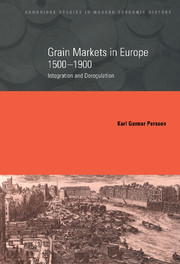Book contents
- Frontmatter
- Contents
- List of figures
- List of tables
- Preface
- Acknowledgements
- List of abbreviations
- 1 Bread and Enlightenment: the quest for price stability and free trade in eighteenth-century Europe
- 2 Markets, mortality and human capabilities
- 3 Harvest fluctuations, storage and grain-price responses
- 4 Market failures and the regulation of grain markets: a new interpretation
- 5 Market integration and the stabilisation of grain prices in Europe, 1500–1900
- 6 Authoritarian liberalism and the decline of grain market regulation in Europe, 1760–1860
- Sources
- Bibliography
- Index
5 - Market integration and the stabilisation of grain prices in Europe, 1500–1900
Published online by Cambridge University Press: 10 September 2009
- Frontmatter
- Contents
- List of figures
- List of tables
- Preface
- Acknowledgements
- List of abbreviations
- 1 Bread and Enlightenment: the quest for price stability and free trade in eighteenth-century Europe
- 2 Markets, mortality and human capabilities
- 3 Harvest fluctuations, storage and grain-price responses
- 4 Market failures and the regulation of grain markets: a new interpretation
- 5 Market integration and the stabilisation of grain prices in Europe, 1500–1900
- 6 Authoritarian liberalism and the decline of grain market regulation in Europe, 1760–1860
- Sources
- Bibliography
- Index
Summary
The measurement of market integration
It has been argued in previous chapters that given the high costs of transport, the slow flow of information and the risky nature of local harvest carry-over, harvest fluctuations necessarily had a large impact on supply and prices. But changes in transport and information technology increased opportunities for trade and arbitrage and stimulated integration of markets. In this chapter the extent of market integration through time and its impact on price stability will be documented and analysed. However, to assess the extent of market integration we need a standard. The basic idea applied here is that market integration is related to the homogeneity of information in different markets and the opportunities for arbitrage and trade – that is, for exploiting the gains from moving goods from where prices were low to where prices were high. If all participants shared the same information and transport costs were negligible or stable, price levels would be expected to converge to some equilibrium ratio, of which ‘the law of one price’ must be considered the ultimate one, indicating that price in different locations is equal. However, the law of one price seldom applies literally because transport costs are positive. Markets can be perfectly well integrated when price differentials reflect the transport cost between them.
- Type
- Chapter
- Information
- Grain Markets in Europe, 1500–1900Integration and Deregulation, pp. 91 - 130Publisher: Cambridge University PressPrint publication year: 1999



